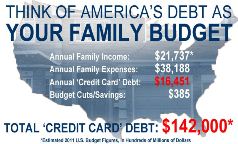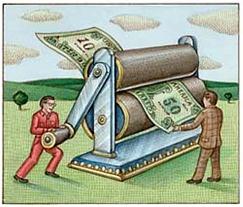 Americans love numbers. We especially love big numbers because big numbers means there can be no argument against whatever point we are using the big numbers for…because they are so BIG.
Americans love numbers. We especially love big numbers because big numbers means there can be no argument against whatever point we are using the big numbers for…because they are so BIG.
Here’s a big one—The National Debt clock at this very moment is $19,856,689,020,596.
It is higher right now as you read this from what it was when I wrote it down. That is daunting. No one can say, “What’s 19 trillion when you’re having fun?”
The number is often used to make the point that government cannot spend any more money, nor borrow any more, to spend on things we don’t need. Things like welfare according to most of those sounding the spending alarm.
But we also love tiny numbers. “1’s” have great impact, primarily when we are talking about percentages. 1% of anything is next to nothing and that can make a very dramatic point.
There was a column in the Waterloo-Cedar Falls Courier that was, more or less, a rebuttal of my column in the paper the previous week. I had written (as I have here, there and everywhere) about how a “compassionate, just, and civilized society offers assistance to those who have fallen through the cracks.” I wrote in defense of welfare spending, and the columnist centered his case on a report that roughly 47 million Americans are receiving food stamps.
He then whittled the math to illustrate how gigantic a number that is by pointing out that to equal it, every Iowan would have to take on 16 boarders.
The columnist was impressing upon us that we cannot, as a nation, afford to pay that kind of money.
Well….here’s where little numbers come in. Food stamps are1% of the federal budget. Personally, if I only get a 1% return or loss on something, I don’t think I even bother to write it down.
The problem with the use of numbers, large or small, is that they can actually take us farther from the truth, because they are so easy to manipulate. Recently I saw a blog post that said that 44% of working age Americans aren’t working and most “don’t want to.” That assumption is already insulting and ridiculous even before we consider that the percentage was arrived at by including young people from the age of 16 to 22.
I guess I was one of those lazy Americans once because I spent those years in school.
Big numbers scare us, little numbers give us pause, but numbers, on the whole, are just ways to fill in blanks. We need to know how many seats are left on the airplane so we can know how many more tickets can be sold, but the plane will still take off whether it’s full or not.
The National Debt is much the same.
The big debt number is flaunted to scare people into believing that government programs must be cut, and if those programs are cut, taxes will go down and we will have more money to spend. That’s not entirely illogical, but it doesn’t tell the whole story. Many services our taxes pay for keep what we would pay out of our own pockets down. Things like federal research in science and medicine, transportation infrastructure, and security, just to name a few.
What aggravates many people are welfare programs, but those critics do not seem interested in the number of people who have been helped by programs to become, or return to being, productive. They are obsessed with the scammers, which evidence shows is a relatively small percentage. Yet they do not seem concerned with 100 billion dollars annually in corporate welfare that only serves to line already well-to-do pockets. That really takes a bite out of our paychecks.
There exists a double-standard because at one time or another 96% of all us have used some sort of federal assistance (I have needed unemployment on a couple of occassions). Perhaps we should be careful when chastising social spending.
 Several sources compare the National Debt in relation to the Federal Budget as being no different from a Household Budget.
Several sources compare the National Debt in relation to the Federal Budget as being no different from a Household Budget.
They aren’t the same. At all.
The most obvious difference is that a household will borrow money (from a lender against future income) to purchase something that they don’t have enough money for today; a house, a car, etc. In contrast, the federal government, since it is the sole issuer of our currency, is never without money. I n reality when government spends in excess of tax receipts, it prints more money.
n reality when government spends in excess of tax receipts, it prints more money.
As much as I’d like to print my own money to pay bills, my household is not afforded that luxury. At least that’s what the Secret Service has told me.
Printing money can cause inflation, but only when measured against stationary production. A real world economic model indicates that more liquidity in the system will cause production to rise and offset inflationary trends. ( http://www.forbes.com/sites/johntharvey/2011/05/14/money-growth-does-not-cause-inflation/ )
Furthermore, a household has a finite period of existence, and therefore, the debt is real, while our government, in theory, goes on in perpetuity. So long as the US dollar remains the world’s primary currency and so long as we are the biggest consumer, there is no time limit for paying back our debt.
What is relevant is the interest that we pay on debt, but even that concern has been exaggerated. Where it stands today, around one and a half percent of the GNP, is manageable. To illustrate, suppose we issue $4 trillion in 30-year bonds at 2.75 percent interest. The economy continues to recover and the interest rate is up around 6.0 percent in a few years. The federal government would be able to buy back the $4 trillion in bonds it had issued for roughly $2 trillion, immediately eliminating $2 trillion of its debt.
The same is true with that food stamp number. Sure 47,000,000 is a big number but any rational perspective will conclude, whether you agree or disagree with stimulus spending, bailouts, extending unemployment benefits, or tax cuts from either the Bush or Obama Administrations, that more people were going to qualify for assistance following an unprecedented recession.
Okay, I’m tossing around big and little numbers, too. My goal is to show how panic, fanned by daunting numbers, is clouding the issues, stagnating progress, and challenging compassion.
I stand by my moral premise: A compassionate and civilized society provides a safety net to everyone, as best as it can.
The numbers, big or small, will support whatever it is you want to believe, and so it comes down to this: What do you believe a great nation provides?
Do you believe that a great, powerful and wealthy nation should not set aside 1% of 3.5 trillion dollars to provide food for people who are making 0 to $15,000 a year?*
 And what is the alternative? Better wages? Better education? More motivational posters?
And what is the alternative? Better wages? Better education? More motivational posters?
I’m listening…
*This is per person and households will have higher combined incomes and receive more assistance due to more family members. Each state has its own guidelines and my numbers are averages.
Good reading: http://malincursive.blogspot.com/2013/04/truth-about-welfare-debunking-welfare.html
http://www.huffingtonpost.com/patrick-takahashi/how-serious-is-our-nation_b_366811.html
http://www.valuewalk.com/2012/03/the-big-bad-national-debt-who-is-afraid/